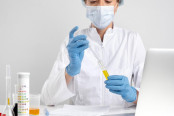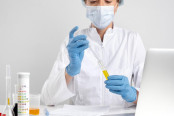Tests for Detection of Blood in Urine
Learn various methods, including microscopic and chemical examination for detecting blood in urine. Explore hematuria, benzidine test, orthotoluidine test and reagent strip test.

The presence of gross hematuria imparts a pink, red, or brown hue to the urine. While the alteration in color may be disconcerting, it's noteworthy that even a minute quantity of blood in the urine can bring about this perceptible change. In most instances, gross hematuria does not elicit pain or other associated symptoms. However, the occurrence of blood clots in the urine may lead to discomfort. Passing blood clots during urination can be a painful experience, and if these clots obstruct the urinary flow, they may result in bladder or back pain.
Conversely, microscopic hematuria, despite not influencing the visible coloration of urine, generally transpires without noticeable symptoms.
Microscopic Examination of Urinary Sediment
Microscopic hematuria is defined as the identification of 3 or more red blood cells per high-power field upon microscopic analysis of urinary sediment in two out of three appropriately collected samples. It is crucial to note that a limited number of red blood cells in low specific gravity urine might undergo lysis, leading to the potential oversight of hematuria if solely relying on microscopic examination. Hence, it is recommended to complement microscopic urine examination with a chemical test for a comprehensive evaluation.
Further reading: Microscopic Examination of Urine.
Chemical Tests for the Detection of Blood in Urine
These assays identify both intracellular and extracellular hemoglobin, encompassing intact and lysed red blood cells, as well as myoglobin. Heme proteins within hemoglobin serve as peroxidases, facilitating the reduction of hydrogen peroxide to water. This enzymatic process requires a hydrogen donor, such as benzidine, orthotoluidine, or guaiac. The oxidation of these hydrogen donors initiates the development of color (refer to Figure 1). Importantly, the intensity of the resultant color is directly proportional to the quantity of hemoglobin present.
Positive results from chemical tests are indicative of conditions such as hematuria, hemoglobinuria, and myoglobinuria. These tests play a crucial role in detecting and distinguishing these pathologic states.

Benzidine Test
Prepare a saturated solution of benzidine in glacial acetic acid. Combine 1 ml of this prepared solution with an equal volume of hydrogen peroxide in a test tube. Introduce 2 ml of urine into the mixture. A positive result is indicated by the development of a green or blue color within 5 minutes.
Orthotoluidine Test
In this assay, orthotoluidine is employed in lieu of benzidine, imparting a heightened sensitivity compared to the benzidine test. This modification enhances the precision and accuracy of the test, making it a more discerning method for the detection of specific reactions.
Reagent Strip Test
Several commercially available reagent strips utilize diverse chromogens, including o-toluidine and tetramethylbenzidine. These strips serve as valuable tools in diagnostic processes, each employing distinct chemical compounds to facilitate precise and reliable results.
Causes of false-positive tests:
- Urine contamination with menstrual blood in females
- Urine contamination due to the presence of oxidizing agents (such as hypochlorite or bleach used for cleaning urine containers) or microbial peroxidase in the context of urinary tract infections.
Causes of false-negative tests:
- Elevated concentrations of a reducing agent, such as ascorbic acid: Microscopic examination reveals the presence of red cells, but the chemical test yields a negative result.
- Utilization of formalin as a urine preservative
Refer to Figure 2 for the illustration of the assessment of a positive chemical test for blood.
Further reading: Chemical Examination of Urine.

Cite this page:
- Comment
- Posted by Dayyal Dg.
From Around The Web
-

Test for Detection of Bile Salts in Urine
Pathology / Clinical Pathology -

Test for Detection of Bilirubin in Urine
Pathology / Clinical Pathology -

Test for Detection of Urobilinogen in Urine
Pathology / Clinical Pathology -

Tests for Detection of Glucose in Urine
Pathology / Clinical Pathology -

Tests for Detection of Ketones in Urine
Pathology / Clinical Pathology -

Tests for Detection of Proteinuria
Pathology / Clinical Pathology